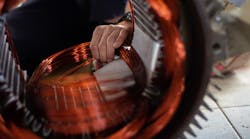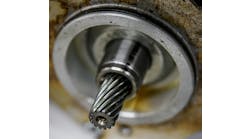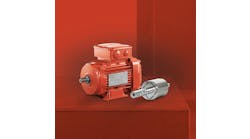When I was going to college to earn my diploma, I spent a couple of co-operative education terms working for an electrical motor repair shop. For a young person just getting into what would become a career, this was a perfect work placement.
We were located just two minutes away from a major cereal-and-corn-starch-production facility, and we were the emergency repair point for large or customized electrical motors. Anything from a fractional horsepower single-phase induction fan or pump motor up to 100 hp or more came across my work bench.
While I was primarily the initial testing technician and could perform bearing changes and brush replacement, I was keenly fascinated by the rewind operation just across the aisle from my work bench.
Prior to working there, I had no idea that one could bake a rotor or stator in a high-temperature oven to burn off all the insulation and then remove the windings in order to rebuild the motor.
The most amazing memory of that experience was what the 90-year-old owner, Art Jenkins, had stored in his mind from his life experience. You could tell him the number of poles, desired horsepower and speed of any motor, and he would tell you the gauge of wire, number of windings and configuration of the windings that were required to restore that motor to operation.
This wasn’t done by looking it up in a book or chart. Art could rhyme it off from memory. My fascination of Art’s core understanding of motors was a key element in propelling me into this field of control design.
As a control designer, we always want to choose from the latest product offerings of our component vendors. The primary reason for this is to take advantage of the latest technical advances. Secondary to that is the need to replace a defective component.
When it comes to machine control design, conventional and servo motors take up a large space in the budget, and an equally significant consideration in the approach to the controls we choose for the application. Advances in this technology tend to fly under the wire. The automation world tends to focus on the brains of the system like programmable controllers and operator stations, and the corporate world is all tied up in the Internet of Things (IoT), digital twins and big data.
So, what is going on in the world of motors and drives? The general target of any technical revolution is to make something better using fewer resources. Plainly stated, we want to make something that runs on less energy, and we also use less energy to make that something.
Here are some examples of innovation to consider.
An induction motor is called that because we use the specific placement of loops of wire—windings—around a metallic core to produce an electromagnet field when electricity is applied to those windings. The stator—that collection of windings around a core—induces magnetic fields that cause the rotor to turn when the fields of the stator interact with the fields on the rotor. The net result causes rotation that can be used to put things in motion.
Let’s talk about those windings for a minute. The traditional winding is just that, a length of wire wound around a specific path that is then laid into the gaps in the core of the stator. Each winding has the same length of wire of a specific cross-section—gauge—wound in the same geometric shape so that, when complete, each winding will produce the same electromagnetic field when power is applied to it. Now we can’t just take bare wire and wrap it around a shape to make these windings. The wire must be insulated.
Now, imagine that conformed loop of wire. Wire is round, and then we dip it in an insulating material. We want enough insulation to allow for the flow of electricity but with enough dielectric strength so that the electricity doesn’t want to jump from one loop of conductor to another. The net result of all those loops of wire is, no matter how accurately we position adjacent loops, there will always be a bit of air gap between them.
The less compact the wire bundle is, the weaker the magnetic field generated. One manufacturer proposed to use square wire. As one can imagine, square wire, with square shaped insulation around it, nestles quite nicely into the adjacent loops of conductor.
The net result is less air gap and better magnetic fields being generated. So, for the same physical area, the motor can be more powerful because the magnetic fields that are generated are better. Conversely, for the same power output, the motor size can be smaller.
Here is another innovative idea. Traditionally, a rotor will be cast out of aluminum. Aluminum doesn’t conduct electricity nearly as well as copper, for example, so why would we cast the rotor out of aluminum? Well, it comes down to the properties of the metal.
Aluminum melts at a far lower temperature (1,220 °F) than copper (1,981 °F). This means that the processes used to form the rotor can do so at much lower temperatures. Lower temperature means lower cost to produce. We can produce far more efficient motors that use less energy to produce and use less energy to operate.
Another facet of motor technology that has improved power and efficiency of motors is the use of permanent magnets. In a traditional induction motor, there are no magnet fields until energy is applied to the windings. By embedding a strong, rare earth or ceramic magnet in the rotor of a motor, the magnetic field is already there before power is even applied.
A permanent magnet motor has torque-to-weight ratios that are double what an induction motor can produce, and the motor can spin at various speeds, as well as generate a higher magnetic field in a smaller package. The electric-car market is benefitting from this technology because the motor is so powerful and efficient that it can be used in applications where it can eliminate the need for a costly and inefficient gearbox.
Other manufacturers are playing with the flux field to improve function. Flux is the magnetic field that is generated in a motor. Traditional motors generate a radial flux that is perpendicular to the rotation of the motor. To make more powerful motors, you need to either make the circumference of the motor larger to house more loops in the windings or make the motor longer to achieve the same thing.
By making the flux field axial—parallel to the rotation of the motor—the motor design can be much more compact. Another manufacturer is working on technology to make a trapezoidal radial flux. The concept, again, results in a smaller motor package for the same power output.
All of these innovations are targeted at improving power while reducing the size of the package and, importantly, creating devices that use less energy. The smaller the package, the more can be done with it.
Motors and servos are everywhere in technology. This has progressed far enough that traditional pneumatic or hydraulic applications can use motors for the same result.
Producing air costs money, so eliminating the use of pneumatic devices in a design is a desirable objective. The use of a stepper or servo in a linear actuator can make the action faster, with more control over the end device and greater accuracy over the motion due to the ability to use an encoder to provide direct feedback of the movement.
Hydraulics are messy to work with and, while powerful, need to be large to achieve the goal. Stronger motors in smaller packages make many things possible that would have been prohibitive in the not-too-distant past.
We often focus on the control side of the equation when it comes to control design. The servo or variable-frequency drive is where the smarts are located, but the core function of the motor is what makes the object move. Smaller motors that are more powerful and more efficient mean you don’t have to have such a large drive in your control cabinet.
This makes it possible for some drives to have multiple-axis control in the same physical package. The enclosure can be smaller, or you can do more with the same size enclosure.
The focus on a greener tomorrow has placed the spotlight clearly on the electric-vehicle market. The benefit of that focus is bouncing right back into the controls industry as the desire to operate a vehicle off a battery has given us the ability to make complex machines that cost less and give us more freedom in design.
I often wonder what my good friend Art would think about what we are doing with motors. I think he would be happy about how far we have come.





